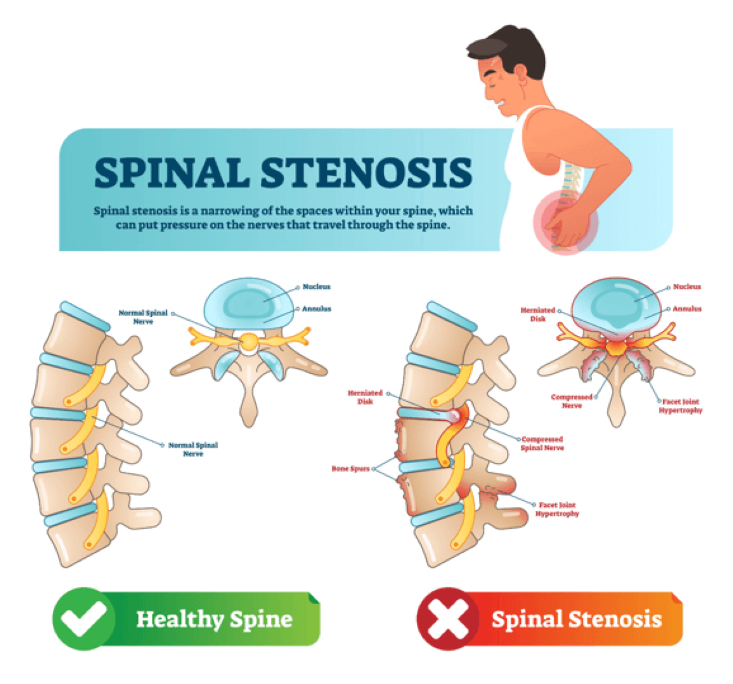Lumbar canal stenosis is a condition that affects the lower part of the spine, where the spinal canal narrows and compresses the spinal cord and the nerves that travel from the lower back to the legs. This narrowing can cause discomfort, pain, and various neurological symptoms. It primarily affects older adults and can significantly reduce their quality of life if not properly managed or treated.
In this blog, we’ll dive deep into what lumbar canal stenosis is, its causes, symptoms, and diagnosis, along with the treatment options available to manage the condition.
What is Lumbar Canal Stenosis?
The lumbar spine is composed of five vertebrae that make up the lower part of the spinal column. The spinal canal is the space within the vertebrae that houses the spinal cord and nerves. When the spinal canal narrows, it can put pressure on these nerves, leading to a variety of symptoms such as pain, numbness, and weakness.
The narrowing, or stenosis, can occur for several reasons, with the most common being age-related degeneration of the spine. As we age, our spine undergoes changes, including the wear and tear of discs and joints, which can lead to stenosis.
Types of Lumbar Canal Stenosis
Lumbar canal stenosis can occur in two main forms:
- Central Stenosis: This occurs when the central part of the spinal canal becomes narrowed, putting pressure on the spinal cord and the nerves that control motor and sensory functions in the lower body.
- Foraminal Stenosis: In this type, the narrowing occurs in the small openings (foramina) where the nerve roots exit the spinal column. When the foramina become narrowed, it can pinch the nerve roots, leading to localized or radiating pain.
Causes of Lumbar Canal Stenosis
The main causes of lumbar canal stenosis include:
- Degenerative Changes: With aging, the spinal discs, which act as cushions between the vertebrae, lose water content and shrink. This can lead to bulging discs, thickening of ligaments, and the development of bone spurs, all of which can reduce the space in the spinal canal.
- Arthritis: Osteoarthritis, which causes the breakdown of cartilage between the joints, is a common cause of spinal stenosis. It can lead to bone spurs and inflammation that narrow the spinal canal. Rheumatoid arthritis, a condition that causes inflammation of the joints, can also contribute to stenosis, though it is less common.
- Herniated Discs: When the discs between the vertebrae become damaged or slip out of place (herniate), they can press on the spinal cord or nerve roots.
- Injuries: Trauma to the spine from accidents or falls can result in fractures or dislocations that narrow the spinal canal and cause compression of the spinal cord or nerves.
- Congenital Stenosis: Some people are born with a narrower spinal canal, making them more susceptible to developing stenosis later in life.
- Tumors or Abnormal Growths: Although rare, abnormal growths or tumors in the spine can lead to stenosis by compressing the spinal canal.
- Thickened Ligaments: The ligaments that support the spine can thicken and stiffen with age, causing them to bulge into the spinal canal, contributing to narrowing.
Symptoms of Lumbar Canal Stenosis
Symptoms of lumbar canal stenosis can vary depending on the location and severity of the narrowing. Common symptoms include:
- Pain in the Lower Back: This is often the first sign of lumbar canal stenosis. The pain can range from mild to severe and may worsen with activities such as standing or walking.
- Leg Pain (Sciatica): Stenosis often causes pain that radiates from the lower back into the legs. This is commonly referred to as sciatica, and it can feel like a sharp, shooting pain that runs down the buttocks and legs.
- Numbness or Tingling: Compression of the nerves in the lumbar spine can cause numbness, tingling, or a “pins and needles” sensation in the legs, feet, or buttocks.
- Weakness in the Legs: Some patients may experience muscle weakness in the legs or feet, making it difficult to walk or perform activities that require leg strength.
- Cramping: Leg cramping, especially after prolonged periods of walking or standing, is a common symptom. The discomfort may ease when the person sits down or leans forward.
- Difficulty Walking: As the condition progresses, patients may experience difficulty walking or standing for long periods, often needing to rest or sit down after short distances.
- Loss of Balance: In more advanced cases, lumbar canal stenosis can affect a person’s balance, making them more prone to falls.
- Bowel or Bladder Problems: In severe cases, stenosis can affect the nerves that control bowel and bladder function, leading to incontinence. This is a medical emergency and requires immediate attention.
Diagnosis of Lumbar Canal Stenosis
The diagnosis of lumbar canal stenosis typically involves a thorough evaluation of the patient’s medical history, physical examination, and imaging tests. Doctors look for symptoms such as pain, numbness, and weakness in the legs, as well as any changes in walking or posture.
- Physical Examination: During the exam, doctors check for signs of nerve compression by assessing the patient’s reflexes, muscle strength, and range of motion.
- Imaging Tests:
- X-rays: X-rays can help identify bone abnormalities such as bone spurs or fractures that may be contributing to the stenosis.
- Magnetic Resonance Imaging (MRI): MRI is often the best test for diagnosing lumbar canal stenosis as it provides detailed images of the spinal cord, discs, and nerves.
- Computed Tomography (CT) Scan: A CT scan, sometimes combined with a myelogram (a dye injected into the spinal fluid), can provide cross-sectional images of the spine, showing the degree of narrowing.
Treatment Options for Lumbar Canal Stenosis
The treatment for lumbar canal stenosis depends on the severity of the symptoms. Treatment options can be divided into two main categories: conservative (non-surgical) treatments and surgical interventions.
Conservative Treatments
- Physical Therapy: Physical therapy is often the first line of treatment. A physical therapist will design a program to strengthen the muscles around the spine, improve posture, and increase flexibility. This can help reduce pressure on the spinal nerves and alleviate pain.
- Medications: Over-the-counter pain relievers such as nonsteroidal anti-inflammatory drugs (NSAIDs) can help reduce pain and inflammation. In more severe cases, prescription medications like muscle relaxants or narcotics may be used for short-term pain relief.
- Corticosteroid Injections: Corticosteroid injections, also known as epidural injections, can help reduce inflammation and relieve pain in the affected area. These injections are typically used when other treatments fail to provide sufficient relief.
- Activity Modification: Patients are advised to avoid activities that aggravate their symptoms, such as prolonged standing or walking. Resting or sitting with the back in a slightly flexed position can help alleviate symptoms.
Surgical Treatments
When conservative treatments do not provide adequate relief, or if the stenosis is severe, surgery may be necessary. The goal of surgery is to relieve pressure on the spinal cord and nerves by creating more space in the spinal canal.
- Laminectomy: A laminectomy is the most common surgical procedure for lumbar canal stenosis. During this surgery, the surgeon removes part of the vertebra (the lamina) to enlarge the spinal canal and relieve pressure on the nerves.
- Spinal Fusion: In some cases, spinal fusion may be necessary to stabilize the spine. This involves joining two or more vertebrae together using bone grafts or metal hardware.
- Foraminotomy: This procedure enlarges the foramina (the openings where nerve roots exit the spinal column), reducing pressure on the nerve roots.
- Interspinous Spacers: These are small devices implanted between the vertebrae to keep the space open, relieving pressure on the nerves.
Living with Lumbar Canal Stenosis
Living with lumbar canal stenosis can be challenging, but there are ways to manage the condition and improve quality of life. Patients are encouraged to:
- Stay Active: Gentle exercises, such as walking, swimming, or yoga, can help maintain flexibility and strength without aggravating symptoms.
- Maintain a Healthy Weight: Excess weight can put additional stress on the spine, so maintaining a healthy weight is important for managing lumbar canal stenosis.
- Practice Good Posture: Proper posture can reduce pressure on the spine and improve alignment, helping to prevent the condition from worsening.
- Use Assistive Devices: For those with difficulty walking, assistive devices such as canes or walkers can help provide stability and reduce the risk of falls.
Conclusion
Lumbar canal stenosis is a common condition that can cause significant discomfort and mobility issues, particularly in older adults. Early diagnosis and treatment are key to managing symptoms and preventing further complications. While conservative treatments can often provide relief, surgical options are available for those with more severe cases. With the right care and lifestyle adjustments, individuals with lumbar canal stenosis can continue to lead active and fulfilling lives.
For Consultation Contact us on 9158680739
Website – www.chetnahospital.co.in
Address – Chetna Hospital, Sambhajinagar, MIDC, G Block, Near Rotary Club, Chinchwad 411019
.
.
.
#pune#pcmc#chinchwad#hospital#medical#medicalservices#spinesurgeon#backspecialist#sciatica#sciaticnerve#sciaticapain#sciaticatreatment#spinesurgery#spinespecialist#spinedoctor#backpaindoctor#endoscopicspinesurgery#orthopaedicsurgeon#mistlifsurgery#cervicalpain#spinalcord#rediculopathy#backpainrelief#slippeddisc#spine#neckpain#spinalstenosis#lumberlordosis#backbonesurgery













